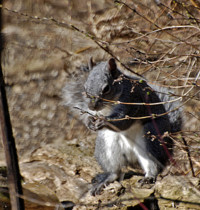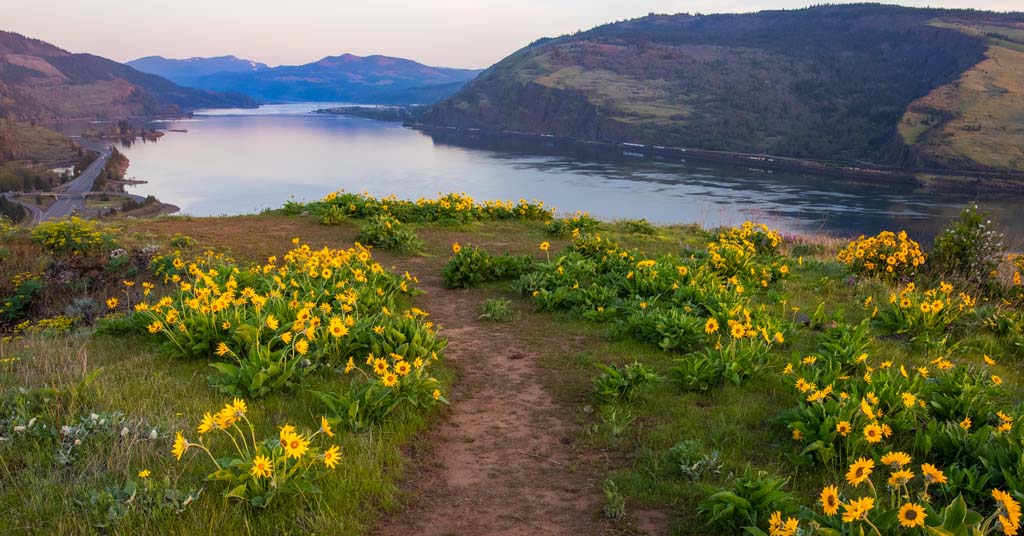By Valerie Brown. Tradition has it that east and west can never meet. Turns out that’s not true. In the Columbia River Gorge east and west meet in a fascinating blend of ecological features, and there is one adaptable tree that thrives in both wet and dry Gorge habitats: The Oregon white oak, Quercus garryana.
Not only does the Oregon white oak take good care of itself wherever it gains a foothold, but it also provides a rich array of benefits for everything ranging from jays and squirrels to turkeys and truffles. The species’ modern range extends from Vancouver, British Columbia to near Los Angeles and on the eastern slopes of the Washington and Oregon Cascades. Oaks occur along the Columbia River from the Pacific Ocean to about Goldendale, Washington.
In the Pacific Northwest, Oregon white oak is far better known west of the Cascades, especially in the Willamette Valley, large swaths of which were formerly covered with oak savanna. Today these areas are much reduced but can still been seen in parts of the valley, particularly around Salem amid rolling hills, fields and vineyards. In Salem, Bush’s Pasture Park maintains an elegant stand of the oaks, which also shelter native camas along the park’s eastern border. Before Europeans arrived, the Kalapuya Indians managed the oak stand and camas using controlled burns.
 [/media-credit]
[/media-credit]
But if you go looking in the Gorge for oaks like the ones in Salem, you might not find them. Q. garryana is something of a shape-shifter. Where it is grouped together with others of its kind, it grows tall and develops a canopy reminiscent of a champagne flute. Where it is sparser, growing in more open areas of scrub and grassland, it takes on a mushroom shape. And in the Gorge’s more severe habitats like cliff-faces and ridgetops, it becomes gnarled and low-growing.
The Columbia Land Trust’s oak restoration project on the lower Klickitat River in Washington is a good place to see oaks in their various shapes, says Lindsay Cornelius, the Trust’s Gorge and East Cascades Stewardship Lead. Along Dillacort Creek there is a short hiking trail (although with a lot of poison oak, she cautions) and plenty of places on State Road 142 to pull over and survey the landscape.
Oregon white oaks have historically been something of a poor relation to trees considered more valuable. Douglas fir is probably the richest relation, being much more desirable for timber. On the east side of the Cascades, oaks have at times been specifically removed to grow conifers for this purpose. Since fire has been suppressed, many oaks in natural mixed stands with Douglas fir have been stunted or killed because the latter grows much faster and cuts off the light. The difference in perceived value between the two species may have led people to discount the loss of the oaks.
Agriculture, development, and various uses for the wood have also contributed to the oaks’ decline throughout much of their range. Invasive plants like Scotch broom and Himalayan blackberry interfere with oak seedling survival. Along the Columbia, oaks were burned to produce steam for sternwheelers in their heyday, says Cornelius, and people still burn Oregon white oak in wood stoves. The wood is also sometimes used for flooring and furniture.
But these days the virtues of Q. garryana are starting to be better understood. While west-side groups have been working to restore oak habitat for many years, it’s a relatively new idea for Gorge and east-side conservationists.
“A number of individuals and agencies are starting to have a general conversation, a growing interest and appreciation of white oaks,” says Dan Richardson, watershed resource technician for Washington’s Underwood Conservation District. Oregon white oaks are “just about our most important wildlife tree,” Richardson adds. “Insects, birds, even large mammals like bobcats will find places to den because oaks tend to lose a limb from time to time and open up a hollow. There is a lot of cavity nesting.”
Q. garryana is also hollow inside, says Cornelius, which means that in addition to providing “all the benefits of a living tree—leaves, acorns, mycorrhizal fungi to supportthe roots, and insects —it also functions as a snag would function” in the way Richardson describes. And speaking of fungi, the white oak is often host to numerous species including truffles, a favorite food of the threatened western gray squirrel, which prefers Oregon white oak habitat, especially in the Gorge. Some 200 vertebrate species have been associated with oak ecosystems. Balch Lake, located in a mixed oak and pine savanna east of White Salmon, is critical habitat for one of two natural western pond turtle populations in Washington.
Mature trees that have room to spread out are particularly good for birds, including acorn woodpeckers, downy woodpeckers and scrub jays. Lichens and bryophytes on older trees host insects and other invertebrates favored by wrens, vireos and nuthatches. One bird that has almost completely disappeared along with the oak savanna is Lewis’s Woodpecker, but it has been spotted as recently as March 12, 2014 in Gorge oak habitat in Lyle, Washington by Lyn Topinka.
Oaks’ adaptability and hardiness bode well for their capacity to adjust to future disruptions, of which climate change is a major concern. Oaks are surprisingly drought-resistant, and the east end of the Gorge in particular is likely to become drier. Oaks’ deep taproots allow them to find groundwater other trees may not be able to reach.
They also tolerate fire well, another advantage in a hotter climate regime.
“If an oak is burned intensely and the whole top of the tree is killed, it will sprout back from the base quite profusely,” says Andrew Bower, a geneticist with the U.S. Forest Service. Bower is studying the genetic differences between oak populations on either side of the Cascades. “A fire may kill all the leaves from this year,” he adds, but “a lot of times they’ll resprout from the trunk or branches next year.”
While projects to encourage white oaks in the Gorge may not actually be returning the landscape to a pre-European configuration, there is little disagreement that fostering healthy white oak habitat is a good idea. The multiple ways Oregon white oaks provide food and habitat for many different species suggest that they can probably help stabilize ecosystems at risk from the stresses of climate change and further development.
“What I often ask,” says Cornelius, “is whether it’s important to go back to what it was, or is it [more] important [to know] what’s resilient, what’s likely to survive in the face of looming changes?”
If past evidence is any guide, Q. garryana will be able to blend the best of both worlds, east and west, wet and dry, to flourish in a future Gorge landscape.













Very nice write up on one of my favorite tree species. I’ve heard about the white oak conservation efforts over here on the west side, around Portland, but hadn’t heard about what’s going on in the Gorge. This is good news!
This is a wonderful article–thank you! Gardeners should take note that Oregon white oaks are wonderful trees for Northwest urban and suburban residential spaces, particularly in areas that were previously oak savanna.
Thank you for writing this article. The more oak conservation can be spread the better. A correction: Lewis’ woodpeckers are not that rare, found commonly in every Western state and also in Canada and occasionally across the US. Acorn woodpeckers have only been confirmed in two locations in Washington State…both in Lyle.
Thanks, Bill. For correction on the Lewis’ woodpecker.
Wonderful article. This tree is emblematic of our region and how it adapts to the range of ecosystems is remarkable.
Nice article. Just a couple comments:
1. The Lewis woodpecker is actually quite common here. The over wintering population varies depending on the availability of acorns on which they depend during the cold winter (they are primarily insect feeders during the summer). When there are not enough acorns, they migrate down to S. OR or Calif. where the acorn supply is more diverse ( 1 and 2 year oak spp) and plentiful. But during the summer they are fairly frequent.
2. This second comment is to remind Jurgen Hess that in 1995 or so I told him that we (Forest Service) needed to begin oak restoration with the cutting out of Douglas Fir in Major Creek. I clearly remember discussing this while we looked over the drainage from the high point about the confluence of West and east forks of Major Creek. I want to remind him that he flatly told me to “forget it”. While the public and Forest Service may not have been ready for such activities, it would have saved hundreds of acres of now dead oaks and would have been the right thing to do regardless of the political environment. If we always wait for the political environment to be right, we might be cooked on earth by climate change. The history of thinning oaks goes way back to the late 60’s when Dr. Biswell in UC Berkeley published his work in Yosemite on the role of fire in oak habitat viability – and even further back to Leopold who also referenced oak and fire, not to mention our knowledgeable Native Americans who could have taught many things had we been willing and interested to listen.
But, everyone wants to read more current articles, so it is good that you both are working to help educate today’s publics.
Again, nice article.
Thanks to everybody for reading and commenting on this article! I’d like to note that one of the sources I used for my info about the Lewis’s woodpecker is this document from 2012: http://www.abcbirds.org/newsandreports/special_reports/QuercusGuidePart1.pdf. It says “Lewis’s Woodpecker was formerly an uncommon to locally abundant breeding species in oak habitats in all four of the ecoregions of western Oregon and Washington and southwestern British Columbia. By the early 1960s it began to disappear as a breeding species starting in the Georgia Depression and San Juan Islands of the north Puget Lowlands. By the early 1970s it was gone as a breeding species in the south Puget Lowlands and Willamette Valley. It maintained a breeding presence in the Klamath Mountains through the 1980s, but is currently not known to breed anywhere in these ecoregions. This regional extirpation mirrors the loss and degradation of oak habitats in the region, particularly the extensive areas of oak savannah dominated by large trees which is the required habitat for this cavity-nesting bird. Bringing back breeding populations of Lewis’s Woodpecker, and the expansive oak savannahs they depended on, is a driving vision for bird conservationists in oak habitats of the Pacific Northwest.”
So while it’s very good news that the Lewis’s woodpecker is fairly common in the Gorge, I think it’s still accurate to say that regionally it hasn’t been doing so well. Let’s hope the restoration of the oak helps it re-establish. – Valerie
“Q. garryana is also hollow inside, says Cornelius”
Oregon White Oak may be a great habitat tree because of cavities, but it is not a hollow tree as a species. A tree does not develop a cavity or hollow until there is some kind of wounding or decay. I can just imagine talking to a client about their oak and hearing, “I read somewhere that these trees are hollow, so we should probably cut it down before it falls on my house”. Sure, I am being nit-picky, but I am generally confused by this part of the article.